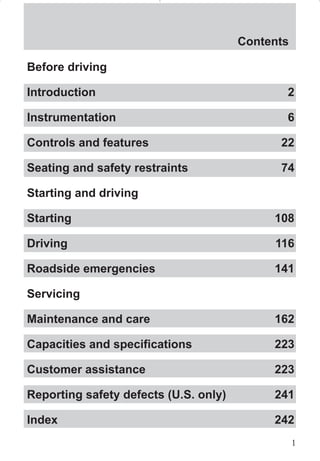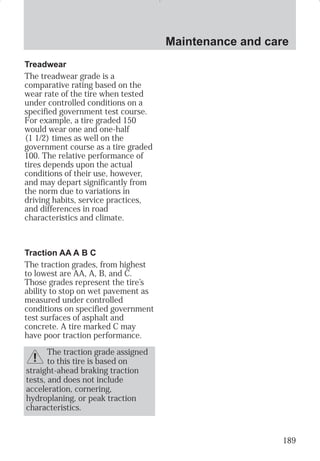The document provides information about vehicle instrumentation and controls for a vehicle owner's manual. It includes a glossary of common vehicle symbols, descriptions of dashboard controls and warning lights, and explanations of what the warning lights indicate. It describes the function of lights related to safety systems, the engine, and other vehicle systems to help the driver understand the vehicle's instrumentation.






















































































![Seating and safety restraints
87
MIRRORS
55
50
40
30
20
60
40
2
4 5
AIR BAG SUPPLEMENTAL
RESTRAINT SYSTEM (SRS)
Important supplemental
restraint system (SRS)
precautions
The supplemental restraint system
(SRS) is designed to work with the
safety belt to help protect the
driver and right front passenger
from certain upper body injuries.
LO OFF PNL/FLR
PANEL
A/C
FLOOR
FLR
DEF
DEF
MAX
A/C
HI
/
POWER AUDIO AM/FM SCAN
SEEK
1 2 3
4 5
ANS
SIDE 1-2
EJECT
VOLUME
000123
0 0 0 0
10
60 70 80
90
100
110
120
130
MPH
20
80
100 120
140
160
180
200
E F
1
0
3
x 1000
6
7
8
BRAKE
CHECK
ENGINE
O/D
OFF
CLOCK
TRACTION
TROL
C H
All occupants of the vehicle
including the driver should
always properly wear their safety
belts even when air bag SRS is
provided.
Always transport children
12 years old and under in
the back seat and always use
appropriate child restraints.
NHTSA recommends a
minimum distance of at least
25 cm (ten [10] inches) between
an occupant’s chest and the air
bag module.](https://image.slidesharecdn.com/00countur-140904144453-phpapp01/85/00-countur-87-320.jpg)






![Seating and safety restraints
Important child restraint
precautions
You are required by law to use
safety restraints for children in the
U.S. and Canada. If small children
ride in your vehicle (generally
children who are 4 years old or
younger and who weigh 18 kg
[40 lb] or less), you must put them
in safety seats made especially for
children. Check your local and
state or provincial laws for specific
requirements regarding the safety
of children in your vehicle.
94
Never let a passenger hold a
child on his or her lap while
the vehicle is moving. The
passenger cannot protect the child
from injury in a collision.
Always follow the instructions and
warnings that come with any infant
or child restraint you might use.
When possible, place children in
the rear seat of your vehicle.
Accident statistics suggest that
children are safer when properly
restrained in the rear seating
positions than in the front seating
position.](https://image.slidesharecdn.com/00countur-140904144453-phpapp01/85/00-countur-94-320.jpg)

















































































































































![Customer assistance
240
ORDERING ADDITIONAL
OWNER'S LITERATURE
To order the publications in this
portfolio in the United States:
Make checks payable to:
HELM, INCORPORATED
P.O. Box 07150
Detroit, Michigan, 48207
For a free publication catalog,
order toll free: 1-800-782-4356
Monday-Friday 8:00 a.m. - 6:00
p.m. EST.,
for credit card holders only.
To order the publications in this
portfolio in Canada
Make cheques payable to:
Ford Motor Company of Canada,
Ltd.
Service Publications
P.O. Box 1580, Station B
Mississauga, Ontario, Canada L4Y
4G3
or order toll free:
1-800-387-4966
Monday-Friday 8:00 a.m. - 6:00
p.m. EST.,
for credit card holders only.
• Mobile communications systems
may harm the operation of your
vehicle, particularly if they are not
properly designed for automotive
use or are not properly installed.
When operated, such systems may
cause the engine to stumble or
stall. In addition, such systems may
be damaged or their performance
may be affected by operating your
vehicle. (Citizens band [CB]
transceivers, garage door openers
and other transmitters with
outputs of five watts or less will not
ordinarily affect your vehicle's
operation.)
• Ford cannot assume
responsibility for any adverse
effects or damage that may result
from the use of such equipment.](https://image.slidesharecdn.com/00countur-140904144453-phpapp01/85/00-countur-240-320.jpg)







